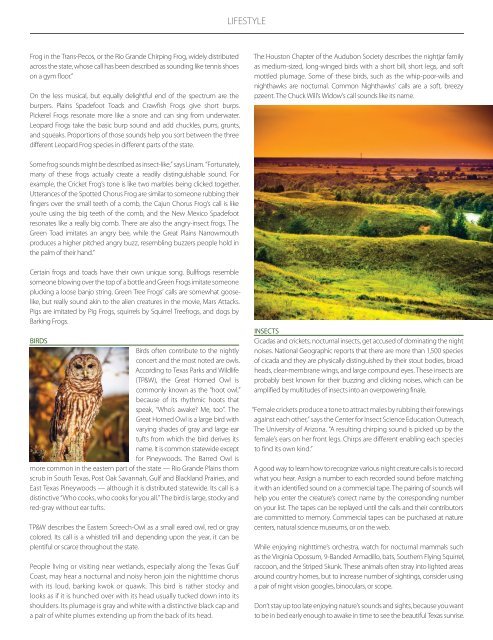Create successful ePaper yourself
Turn your PDF publications into a flip-book with our unique Google optimized e-Paper software.
LIFESTYLE<br />
Frog in the Trans-Pecos, or the Rio Grande Chirping Frog, widely distributed<br />
across the state, whose call has been described as sounding like tennis shoes<br />
on a gym floor.”<br />
On the less musical, but equally delightful end of the spectrum are the<br />
burpers. Plains Spadefoot Toads and Crawfish Frogs give short burps.<br />
Pickerel Frogs resonate more like a snore and can sing from underwater.<br />
Leopard Frogs take the basic burp sound and add chuckles, purrs, grunts,<br />
and squeaks. Proportions of those sounds help you sort between the three<br />
different Leopard Frog species in different parts of the state.<br />
The Houston Chapter of the Audubon Society describes the nightjar family<br />
as medium-sized, long-winged birds with a short bill, short legs, and soft<br />
mottled plumage. Some of these birds, such as the whip-poor-wills and<br />
nighthawks are nocturnal. Common Nighthawks’ calls are a soft, breezy<br />
pzeent. The Chuck Will’s Widow’s call sounds like its name.<br />
Some frog sounds might be described as insect-like,” says Linam. “Fortunately,<br />
many of these frogs actually create a readily distinguishable sound. For<br />
example, the Cricket Frog’s tone is like two marbles being clicked together.<br />
Utterances of the Spotted Chorus Frog are similar to someone rubbing their<br />
fingers over the small teeth of a comb, the Cajun Chorus Frog’s call is like<br />
you’re using the big teeth of the comb, and the New Mexico Spadefoot<br />
resonates like a really big comb. There are also the angry-insect frogs. The<br />
Green Toad imitates an angry bee, while the Great Plains Narrowmouth<br />
produces a higher pitched angry buzz, resembling buzzers people hold in<br />
the palm of their hand.”<br />
Certain frogs and toads have their own unique song. Bullfrogs resemble<br />
someone blowing over the top of a bottle and Green Frogs imitate someone<br />
plucking a loose banjo string. Green Tree Frogs’ calls are somewhat gooselike,<br />
but really sound akin to the alien creatures in the movie, Mars Attacks.<br />
Pigs are imitated by Pig Frogs, squirrels by Squirrel Treefrogs, and dogs by<br />
Barking Frogs.<br />
BIRDS<br />
Birds often contribute to the nightly<br />
concert and the most noted are owls.<br />
According to Texas Parks and Wildlife<br />
(TP&W), the Great Horned Owl is<br />
commonly known as the “hoot owl,”<br />
because of its rhythmic hoots that<br />
speak, “Who’s awake? Me, too”. The<br />
Great Horned Owl is a large bird with<br />
varying shades of gray and large ear<br />
tufts from which the bird derives its<br />
name. It is common statewide except<br />
for Pineywoods. The Barred Owl is<br />
more common in the eastern part of the state — Rio Grande Plains thorn<br />
scrub in South Texas, Post Oak Savannah, Gulf and Blackland Prairies, and<br />
East Texas Pineywoods — although it is distributed statewide. Its call is a<br />
distinctive “Who cooks, who cooks for you all.” The bird is large, stocky and<br />
red-gray without ear tufts.<br />
TP&W describes the Eastern Screech-Owl as a small eared owl, red or gray<br />
colored. Its call is a whistled trill and depending upon the year, it can be<br />
plentiful or scarce throughout the state.<br />
People living or visiting near wetlands, especially along the Texas Gulf<br />
Coast, may hear a nocturnal and noisy heron join the nighttime chorus<br />
with its loud, barking kwok or quawk. This bird is rather stocky and<br />
looks as if it is hunched over with its head usually tucked down into its<br />
shoulders. Its plumage is gray and white with a distinctive black cap and<br />
a pair of white plumes extending up from the back of its head.<br />
INSECTS<br />
Cicadas and crickets, nocturnal insects, get accused of dominating the night<br />
noises. National Geographic reports that there are more than 1,500 species<br />
of cicada and they are physically distinguished by their stout bodies, broad<br />
heads, clear-membrane wings, and large compound eyes. These insects are<br />
probably best known for their buzzing and clicking noises, which can be<br />
amplified by multitudes of insects into an overpowering finale.<br />
“Female crickets produce a tone to attract males by rubbing their forewings<br />
against each other,” says the Center for Insect Science Education Outreach,<br />
The University of Arizona. “A resulting chirping sound is picked up by the<br />
female’s ears on her front legs. Chirps are different enabling each species<br />
to find its own kind.”<br />
A good way to learn how to recognize various night creature calls is to record<br />
what you hear. Assign a number to each recorded sound before matching<br />
it with an identified sound on a commercial tape. The pairing of sounds will<br />
help you enter the creature’s correct name by the corresponding number<br />
on your list. The tapes can be replayed until the calls and their contributors<br />
are committed to memory. Commercial tapes can be purchased at nature<br />
centers, natural science museums, or on the web.<br />
While enjoying nighttime’s orchestra, watch for nocturnal mammals such<br />
as the Virginia Opossum, 9-Banded Armadillo, bats, Southern Flying Squirrel,<br />
raccoon, and the Striped Skunk. These animals often stray into lighted areas<br />
around country homes, but to increase number of sightings, consider using<br />
a pair of night vision googles, binoculars, or scope.<br />
Don’t stay up too late enjoying nature’s sounds and sights, because you want<br />
to be in bed early enough to awake in time to see the beautiful Texas sunrise.
















